Cabo de la Vela feels like the end of the World, a place where nature gets stripped to its bare minimum and dissolved in infinity. Here the meeting of endless dessert sands with the shimmering waters of the Caribbean is splendid, but also marks a harsh boundary beyond which we humans are not welcomed.
Where is Cabo de la Vela?
It is in the Gurajira – the Northernmost peninsula in South America – and is the closest Colombian settlement to Punta Gallinas – the Northernmost point of mainland South America. The peninsula is mainly inhabited by members of the native tribe of the Wayuu which use the plains to raise cattle, sheep, goats and horses.
‘The local indigenous people have a fierce reputation going back to the revolutionary days of Simón Bolívar, when they supported ‘El Libertador’ and were the only indigenous people in Colombia who knew how to ride horses and use firearms. They have never been ruled by the Spanish, and 20,000 of them fought the colonists with arms smuggled by the Dutch and English, contributing to Colombia’s independence. There’s still a fierce pride here, a sense of otherness and resistance that pervades all interaction’ – our guidebook.
‘Gurajira peninsular is not for everyone. Getting here by public transportation involves a bone-shaking ride in the back of a truck, possibly driven at lunatic speed by a man with no apparent fear of death or injury. He may spend much of the journey draining beer cans in a single slug. With luck, his assistant will be reasonably sober and will manage not to fall out of the truck. Fingers crossed’.
Needless to say I was not eager to add another dangerous journey to our rich collection. Then one day I met Daisy – an Australian traveler – by the kitchen stove at Casa Grande, each of us clutching a bag of lentils. We immediately bonded over talk on how to make lentils exciting (my family staple food). While waiting for our boiling pots to finish up their task Daisy told me about her visit to Cabo de la Vela, drawing landscapes and breathtaking sea vistas with the big spoon in her hand.
Daisy was passionate in her story telling. She made me forget about the pain of getting to this Colombian frontier, only the desire to visit remained. A few days later we packed up, said good bye to to the sweet group at Casa Grande and headed North. Two hrs by bus took us to Riochacha, the capital of Gurajira. Then we loaded on a car to Uribia for one hour and got deposited at the truck stop for Cabo de la Vela for the last leg of the journey described in the guidebook. Miraculously a space for four skinny bums was made in the back of a truck that already looked full.
There we met 5 kids travelling on their own to their grandma. They were completely by themselves, well not technically as their goat Añe and a nameless stuffed super monkey were accompanying them as well. Not only the kids were responsible for their 2 year old little sister but also they had to guard a new toilet wrapped in a big plastic bag from breaking on the way. Now when I reflect back, I wonder why Añe was travelling to a place where the ground was sand and goat meat a local culinary specialty called viche…
Add to Añe and the kids an Argentinian couple who made us realize what a leap we have made with our Spanish since our silent days in Buenos Aires; a few impressive old ladies, a few skinny men, tons of luggage on the roof, a man lying on top of the luggage and a cabin stuffed with people – we were 21 in total. I suddenly had a déjà vu back to India where personal space was non-existent, affection and touch the norm and establishing contact with people you have never met almost immediate. And similar to many places in India Urubia was also hot, dirty and loud.
There was even a cow hanging around.
Soon we were on our way. Once we left the city we were in no men’s land and for the first time in mountainous Colombia we were driving through a landscape as flat as a pancake without a dot of green in sight. As we got closer to our destination we started passing small house compounds – rancherias – made of mud bricks and surrounded with thorny cactus fences.
I need to add the deafening sound of wind to the photo above, wind so powerful that it could have easily suffocated me if my long scarf got entangled in the truck’s steel railings. Instead I kept banging my head on the roof every time the truck hit a rut, while sand quickly found its way in my eyes, nostrils and pretty much anywhere it could get blown into. By the time we arrived in town my hair was sticking up like the quills of a porcupine.
One look was enough to determine that there was not much to Cabo de la Vela. You could sum up the city as one long dusty street with houses, a few restaurants and posadas.
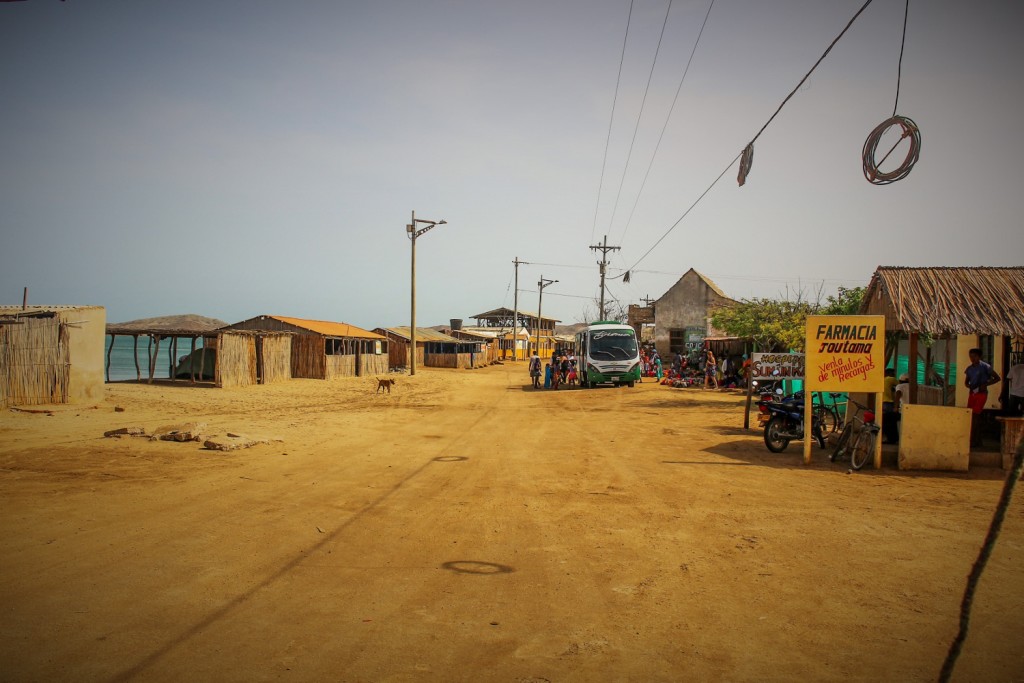
Two things though stood out immediately.
The first was how calm the sea was after all the choppy waters everywhere else on the Colombian Caribbean. Everything was tranquillo except for the wind, flying kite surfers over the green sea expanse. This was the perfect kite surfing paradise – steady wind 365 days/year over flat shallow waters! It was obvious that the outside visitors could easily be divided into two groups – those who came here to kite surf and those who came to here to … get a porcupine hairdo for starters. Don’t get me wrong, we would have loved to add ourselves to the kite surf group, but that pleasure would have cost us $1166/family for a three day course.
Next, the local women and girls got my attention – they stood out with their brightly colored simple dresses without sleeves, but reaching all the way to the ground – something of a moo moo with beautifully embroidered edges. A head scarf for the women hid their hair and matched the dress. Many had their faces painted pitch black to protect them from the sun. And here I have to say that I don’t have a single photo of the ladies as I couldn’t point a camera at them. There was something intimate about being with them and most were shy and private, their voices as low as a whisper. I wasn’t fooled by their gentleness though. The Wayuu society is organized in matrilineal clans, the Wayuu children carry their mother’s last name, making the Wayuu women not only the center of the family but also the cultural leaders of the community as well.
One of the most significant aspects of culture that the Wayuu women practice is the art of weaving mochila bags in the colors of the rainbow. The skill of mochila weaving is passed on from mother to daughter and the traditional patterns go back in time. Ten min from arriving Raina was an owner of two shoulder bags made by a girl not much older than her.
It was getting dark so we quickly found a place for our tent in the posada of a local family. Other guests were sleeping in chinchorros – locally made woolen hammocks. Showers were sold in buckets. We discovered that the four of us can bathe ‘luxuriously’ (R’s term) for 1.5 bucket and we usually had leftover water to wash a few things. Food was mainly fish, a little bit of rice, patacons – mashed fried platanos – and a skimpy amount of vegetables. There was viche of course but we didn’t venture into trying it. Third thing became clear – Cabo de la Vela was not a destination for vegetarians.
To get all personal with the local people you would probably need to visit on a special tour. We, the independent drop offs, had to be satisfied with whatever glimpses we could steal from simple everyday interactions. But then, there was nature all around and with nothing else to do besides kite surfing we ventured out. You see the small triangular mountain in the distance? This is Cerro Kamachi, a sacred place for the Wayuu and the marker for a beach called Pilon de Azucar.
We headed that way on day 2 through the windy nothingness.
After 1 hr we reached the beach. The waters were not as green as Daisy had described them to me, but the place was stunning nevertheless.
We stopped to rest at the sun shelters above the beach and immediately got new friends. The boys abandoned their water selling stations and focused on the attraction of the moment – us. Same would happen everywhere in Cabo de la Vela. Children would surround us in no time and chat us up, sitting so close that our bodies would touch in the heat. This group of boys were not shy. They were terrified by my short hair and kept asking me why I cut it. I killed them by showing them an article on how popular beards are in London (Wayuus don’t have enough facial hair for a beard:) But the last straw was a photo of a woman with a natural beard. That totally floored them.
After some rest and a lunch of crackers and tuna from a can (yuk) we got down to the beach.
A local woman ensured us that the waters were safe for swimming (many Colombian beaches are not), so we stashed the camera behind a rock and jumped in to play with the waves.
Cooled by the sea we set our minds on climbing Cerro Kamachi – the triangular hill – to figure out what was the little stone pillar on top.
Climbing up with flip flops and brutal wind was a workout but we made it to find a stunning 360 deg view and a statue of the Virgin Mary. The wind up high was insane, it felt like it could easily blow us away!
B though thought that the crazy wind was his only chance to kite surf, got himself a sail and proceeded at freaking me out.
We spent another day walking to the light house, watching kite surfers make impossible jumps, swimming, playing soccer with the local kids, eating fish and bathing from buckets. On day three I was ready to go back to a world that had an abundance of fruits and no mischievous wind to throw sand in my eyes all the time.
But shrugging all those minor conveniences away I loved every minute in Cabo de la Vela. This was a place that felt real and unique in all its differences from the world I inhabit. It made me feel so alive with its sun, its shimmering waters, the open vistas, the black skies studded with stars, the quiet and the simple interactions that felt so immediate. It filled me with awe at the human capacity to inhabit the most inhospitable terrain and live with so much less than what I am accustomed to.
Before travelling to Gurajira I worried that I would feel like an intruder to a culture that had been closed to the outside world for a long time. I didn’t. Wayuu more and more depend on tourism to make a living. But I also didn’t learn much about their unique culture, our visit offered just a peak into their way of life. Still, this remote corner of Colombia became a precious piece in the puzzle that makes up this beautiful country.
Without it, my picture of Colombia would be less bright and less vivid.
And now that we have been to the end of the World I feel ready to return home.
I am happy to report that we are not ending our trip soon because the money finished but because we want to stop moving. There are many reasons for that. My backpack is breaking up. My second pair of flip flops is giving in. I am down to one pair of contact lenses. My glasses are completely scratched up. The kids are ready to start school. I am ready to stop packing and unpacking. No one wants to pose for photos, we are lucky if we get a family bum in a shot.
Yap, we got our plane tickets for home. August 5th we should be back in Asheville. Dominican Republic will be our last stop where we are going to meet our little niece/cousin Kalina who managed to almost reach two while we were gallivanting around. We are excited about some family time that will beautifully wrap up our adventure.
And thank you all for keeping us company on the way.
~M

Защо не започнах да пиша и на български от самото начало на блога? Може би застото майка ми, баща ми и най-близките ми приятели знаят английски. Сега съжалявам, но по добре късно отколкото никога, нали?
Този пост е за Кабо де ла Вела, Koломбия, местенце което наподобавя краят на света. Природата е красива, но сурова и пустинният полуостров, който е най-северната точка на Южна Америка, е заобиколен от безкрайното Карибско море. Тази част на Коломбия е много уникална не само заради природата, но и заради културата на местните Wayuu – единствените те не биват завладяни от Испанците. Wayuu се славят с независим и борбен дух, говорят на свой език и имат свои духовни разбирания и традиции. Обществото им е матриархално и жените до този ден са облечени в цветни традиционни рокли с лица боядисани в черно за да се предпазят от слънцето. Те по цял ден плетят чанти с ярки цветове. За съжаление нямам снимка на самите жени, защото им уважих желанието да не ги снимам.
Кабо де ла Вела е единственото селище в Гуажира, което има някаква туристическа инфраструктура, защото залива предлага отлични условия за kite surfing – морето е винаги спокойно а вятъра силен всеки ден. Къщите ca направени от клечки, водата я карат с камион от най-близкият град – душа е кофа с вода за по левче, тоалетната се мие с кофа морска вода, спането е в хамоци и xраната е главно риба или телешко – вегетарианци като нас не могат да отцелеят лесно. Възрастните са сдържани, но децата са много дружелюбни и винаги ни следваха. Всяка вечер ни чакаха да играем футбол до тъмно.
Дали си струваше дългото пътуване до Кабо де ла Вела? Да. Определено. Не само заради красотата на пейзажа, но и заради тези уникални хора който неменуемо ще се променят с развитието на туризма.
А и сега, понеже вече стигнахме до краят на света може да се завърнем в къщи!
М~


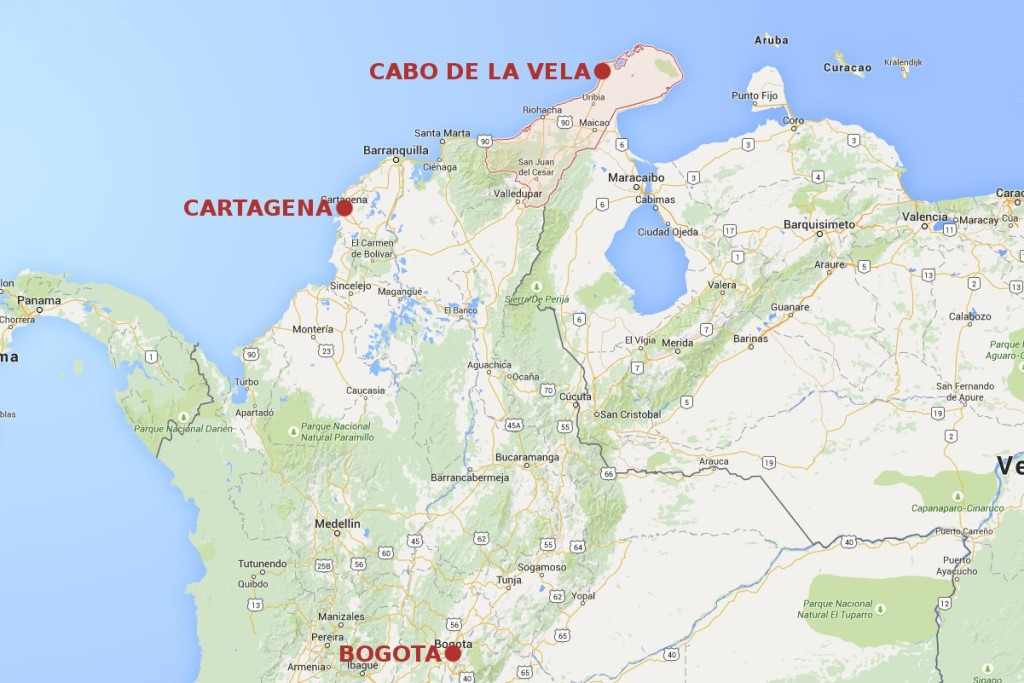
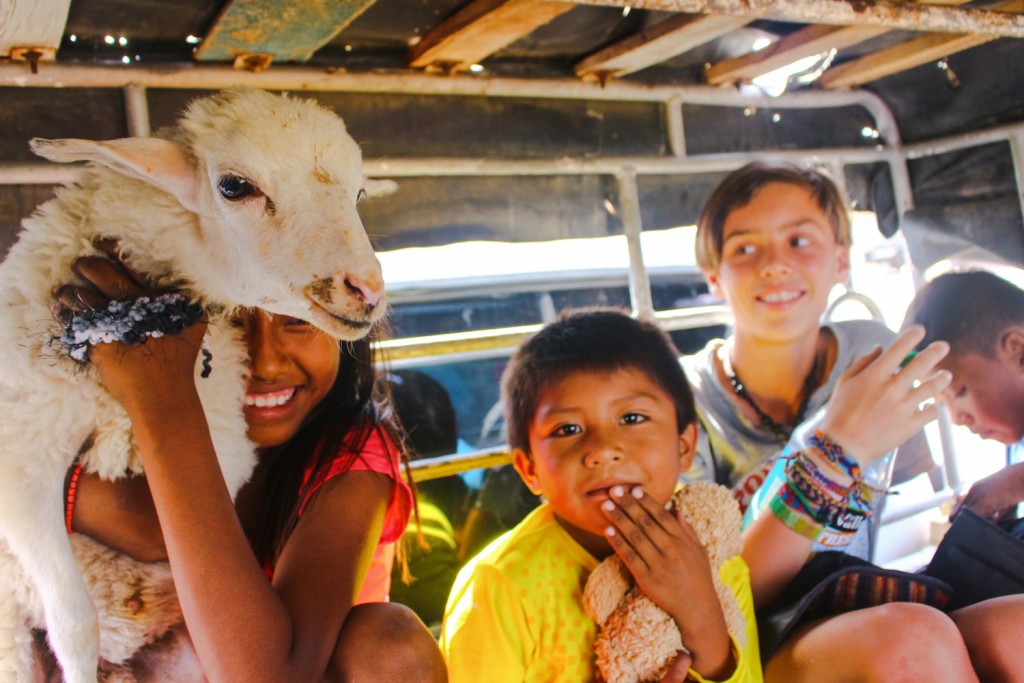
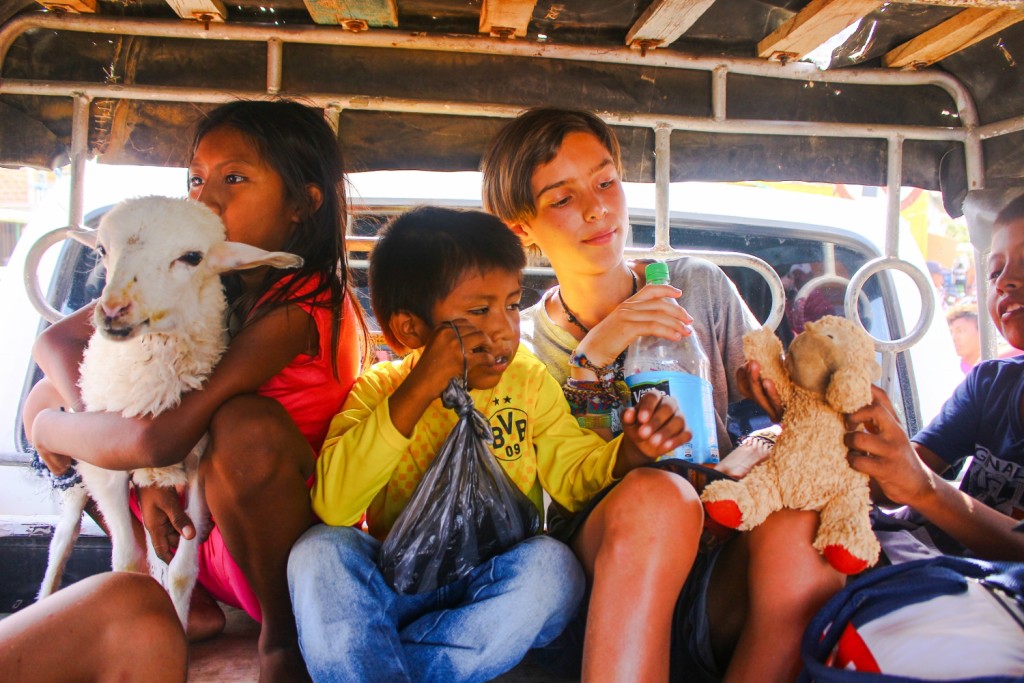




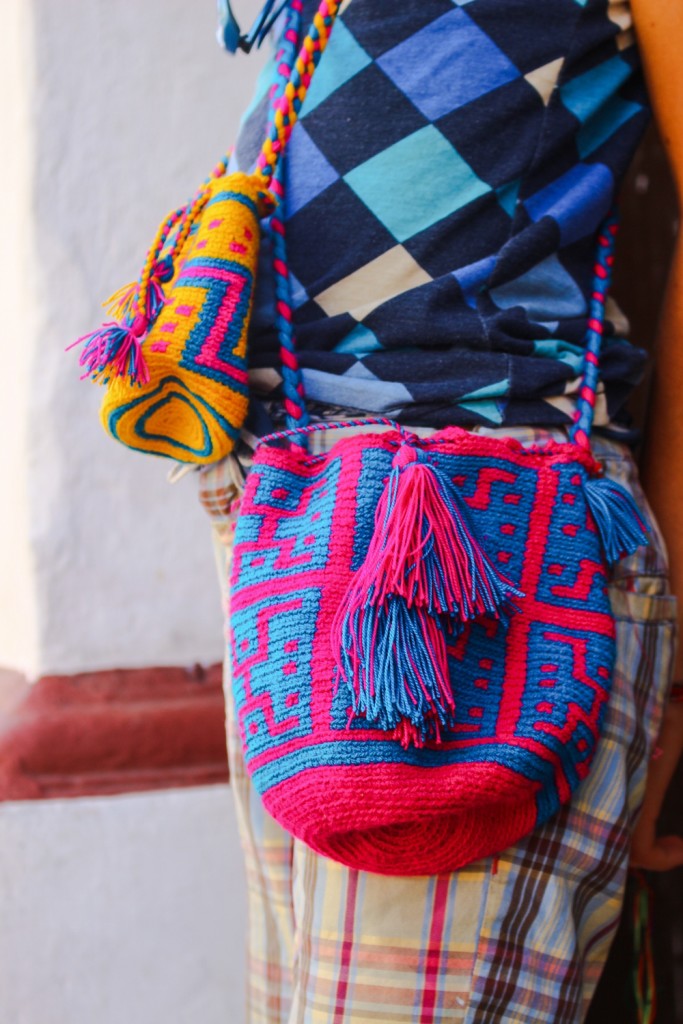
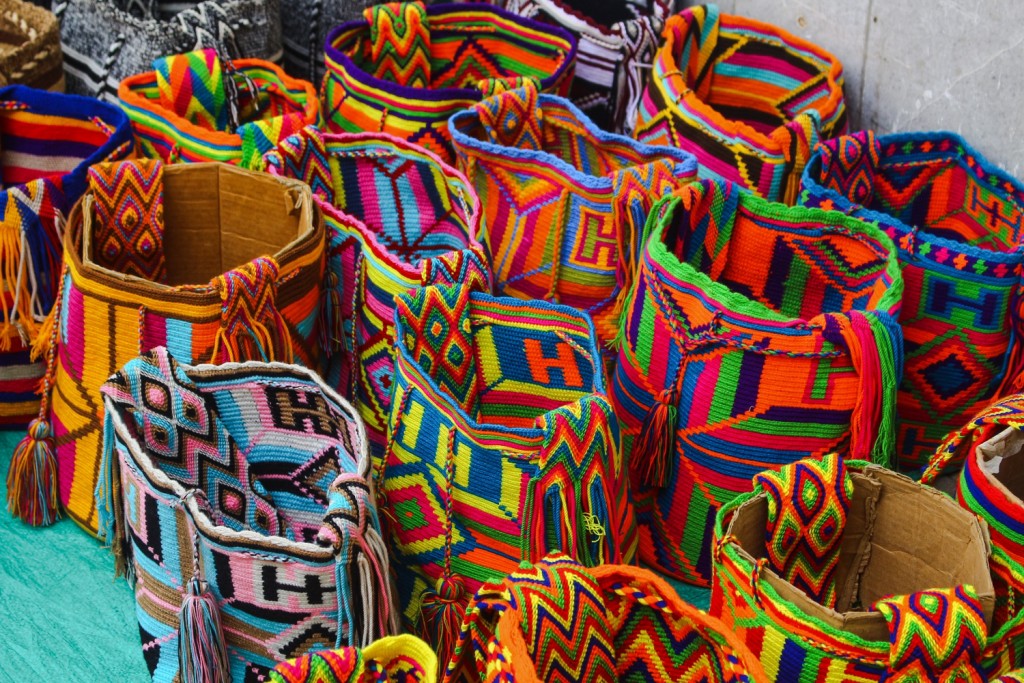
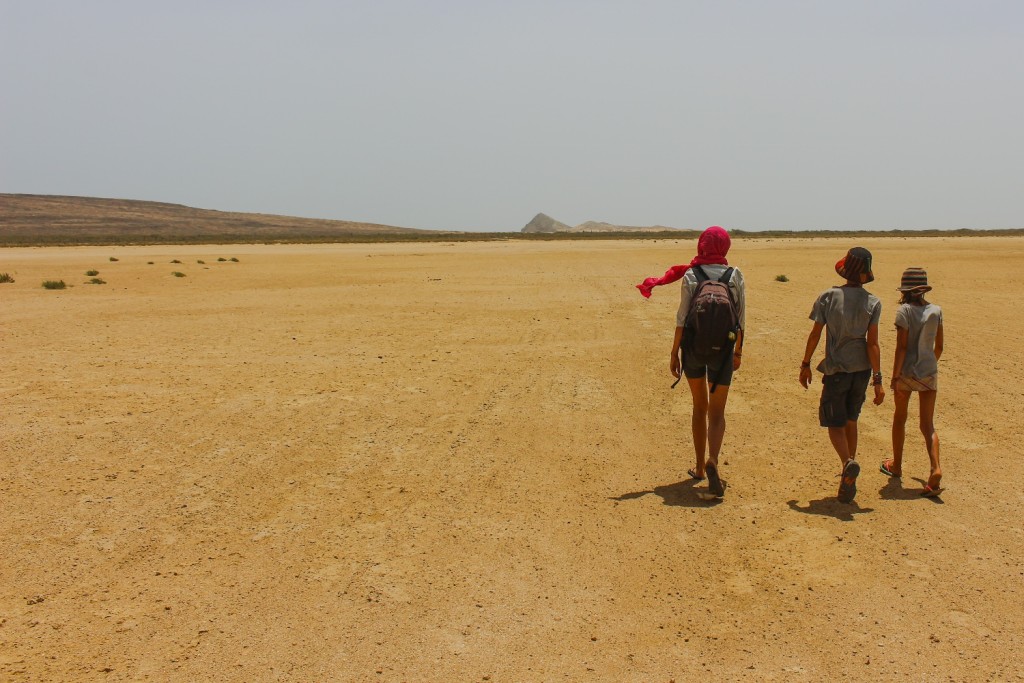
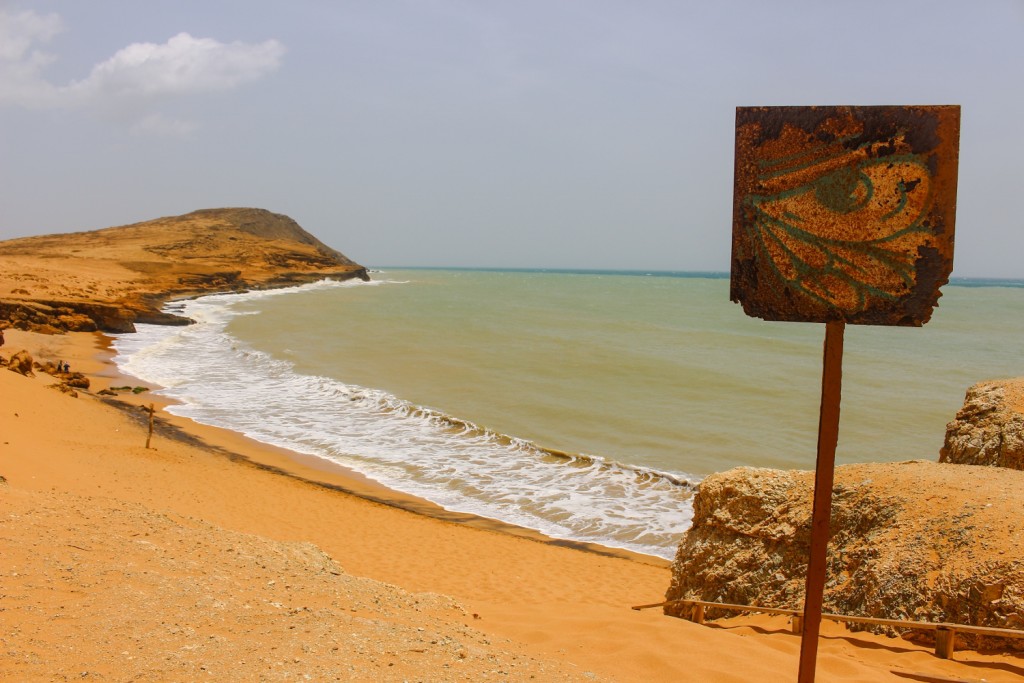

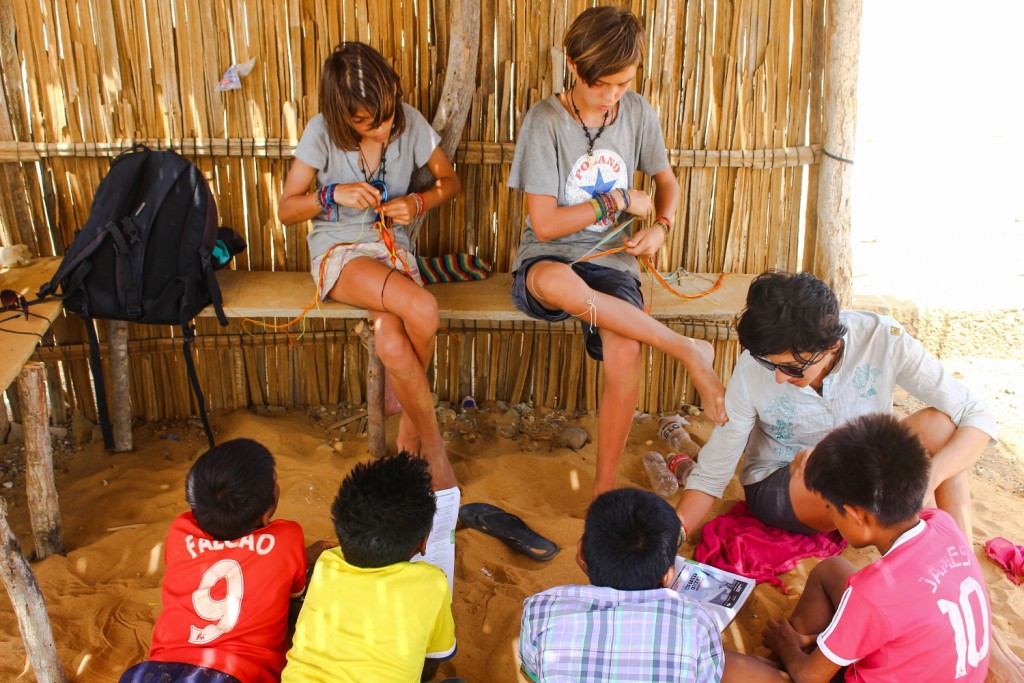



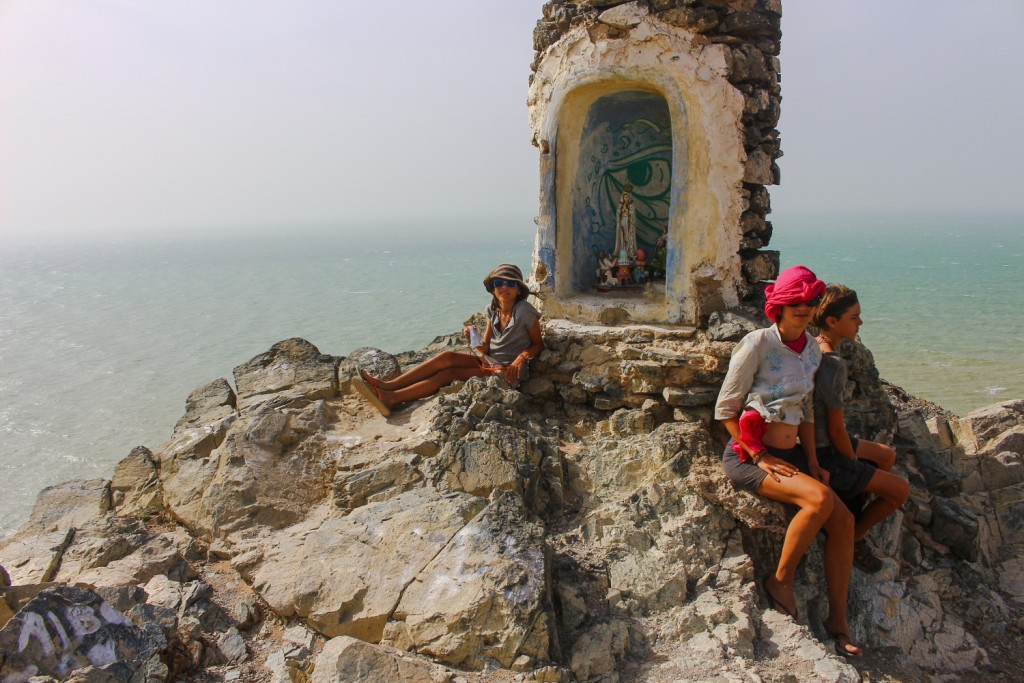
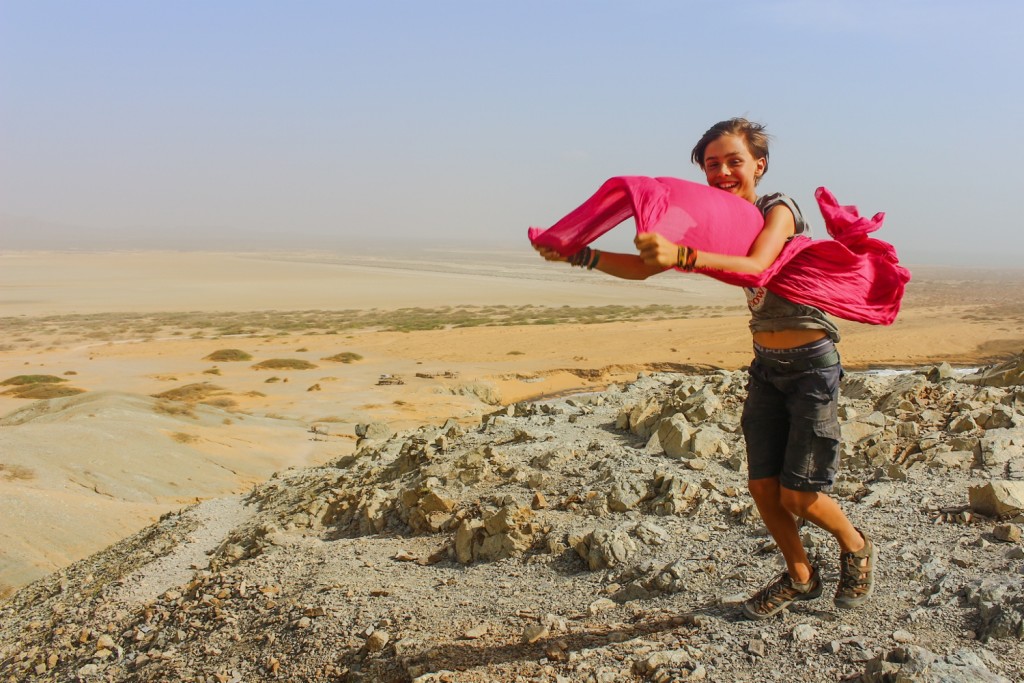
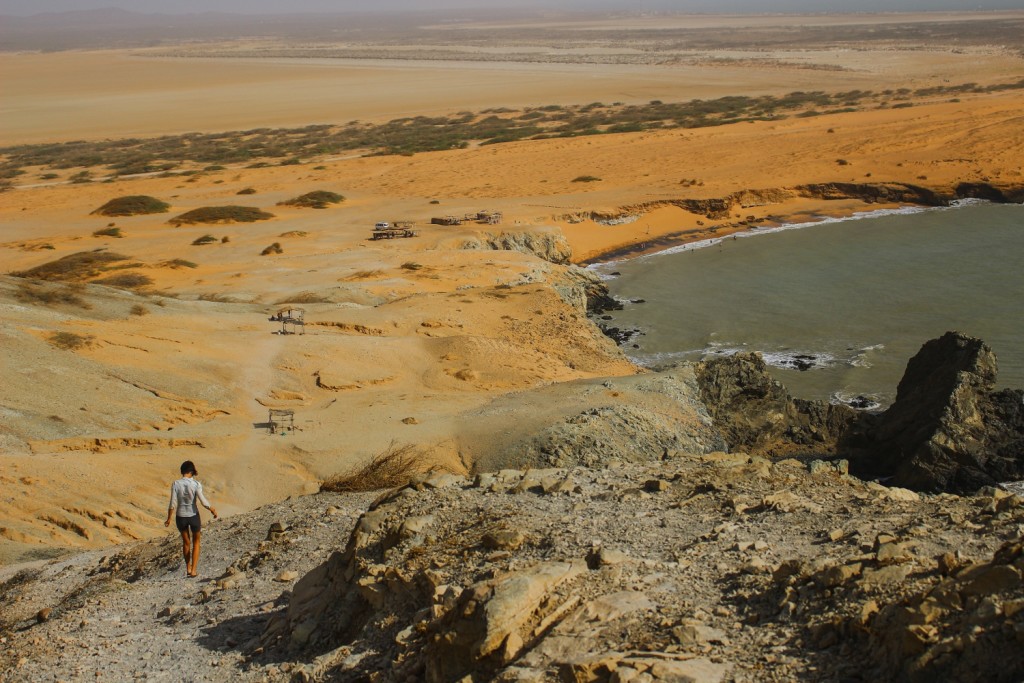

I will miss your posts and your travels, but I know that you’ll be glad (sort of) to be back home in AVL…
Nancy, I hope not to stop traveling and writing, even in a more sporadic fashion. Well, we will see what life brings us. I am actually excited to start working and creating again. My hands are itching! Hopefully things will pick up from where we left them, but one thing I am sure of – there will be more adventures ahead… Cuba for example – we ran out of time on this trip, but I can see a trip to the island in the near near future:)
you will love Cuba! But go soon before it changes too much 🙂
This December hopefully, by then I will be excited for a new adventure. I remember you visited not long ago and loved it:)
Love, love, love your trip and your journaling of it! Looking forward to seeing you all again.
Me too! This is the best part about coming home – seeing all our friends!
Мем,
щом прописа и на български, наистина е дошъл краят на пътуването (не само “краят на света”)!
А светът е наистина прекрасен, и вие сте щастливци, че видяхте толкова много от него
(и ние покрай вас, за което сме много благодарни!)
Много обич от България!
Е де, прописах защото компютъра ме ядоса с тъпият провод на български, но на Якуб майка му горкичката все още чете на развален Полски:( Той ако пропише на Полски, съвсем ще свърши света ха ха. Много обич и от нас. Целувки!!!!!
Koniec Ameryki Południowej, koniec turystycznej przygody, koniec przekazów z odwiedzanych krajów… Zostaną zdjęcia i wspomnienia. Dla mnie też coś się kończy. Codziennie wypatrywałam wieści na FB, czytałam je wnikliwie na ile translator pozwalał.Pośrednio uczestniczyłam w tej podróży. Podziwiałam waszą determinację, odwagę i umiejętności organizacyjne. Szczególnie podziwiałam dzieci za to, że tak dzielnie znosiły wszelkie niewygody i zaskakujące sytuacje. No ale trzeba wracać. Pushek czeka…
Nic nie trwa wiecznie, wszystko dobre co się dobrze kończy, co jeszcze mawiają na temat przemijania? My też mamy mieszane uczucia – podróż była (jest jeszcze i będzie przez chwilę) przepiękna i smutno nam, że się konczy ale także cieszymy się na powrót, nowe początki i następne etapy życiowe.. no i oczywiście na spotkanie z Puszkiem 🙂
Yes, Pushek is waiting, it is high time to go back. I hope she hasn’t forgotten us! And there is still one month left to our travels, maybe Kuba will start finally translating in Polish, so you don’t have to read butchered versions of my writing:) I actually admire your determination in fighting with the google translator, it takes enough patience to make sense of it all, as it takes for us to circle the globe. Love!